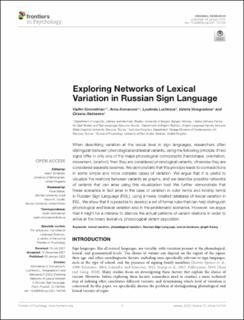| dc.contributor.author | Kimmelman, Vadim | |
| dc.contributor.author | Komarova, Anna | |
| dc.contributor.author | Luchkova, Lyudmila | |
| dc.contributor.author | Vinogradova, Valeria | |
| dc.contributor.author | Alekseeva, Oksana | |
| dc.date.accessioned | 2022-01-27T12:37:31Z | |
| dc.date.available | 2022-01-27T12:37:31Z | |
| dc.date.created | 2022-01-05T12:18:45Z | |
| dc.date.issued | 2022 | |
| dc.identifier.issn | 1664-1078 | |
| dc.identifier.uri | https://hdl.handle.net/11250/2888444 | |
| dc.description.abstract | When describing variation at the lexical level in sign languages, researchers often distinguish between phonological and lexical variants, using the following principle: if two signs differ in only one of the major phonological components (handshape, orientation, movement, location), then they are considered phonological variants, otherwise they are considered separate lexemes. We demonstrate that this principle leads to contradictions in some simple and more complex cases of variation. We argue that it is useful to visualize the relations between variants as graphs, and we describe possible networks of variants that can arise using this visualization tool. We further demonstrate that these scenarios in fact arise in the case of variation in color terms and kinship terms in Russian Sign Language (RSL), using a newly created database of lexical variation in RSL. We show that it is possible to develop a set of formal rules that can help distinguish phonological and lexical variation also in the problematic scenarios. However, we argue that it might be a mistake to dismiss the actual patterns of variant relations in order to arrive at the binary lexical vs. phonological variant opposition. | en_US |
| dc.language.iso | eng | en_US |
| dc.publisher | Frontiers Media | en_US |
| dc.rights | Navngivelse 4.0 Internasjonal | * |
| dc.rights.uri | http://creativecommons.org/licenses/by/4.0/deed.no | * |
| dc.title | Exploring Networks of Lexical Variation in Russian Sign Language | en_US |
| dc.type | Journal article | en_US |
| dc.type | Peer reviewed | en_US |
| dc.description.version | publishedVersion | en_US |
| dc.rights.holder | Copyright 2022 Kimmelman, Komarova, Luchkova, Vinogradova and Alekseeva | en_US |
| dc.source.articlenumber | 740734 | en_US |
| cristin.ispublished | true | |
| cristin.fulltext | original | |
| cristin.qualitycode | 1 | |
| dc.identifier.doi | 10.3389/fpsyg.2021.740734 | |
| dc.identifier.cristin | 1975054 | |
| dc.source.journal | Frontiers in Psychology | en_US |
| dc.identifier.citation | Frontiers in Psychology. 2022, 12, 740734. | en_US |
| dc.source.volume | 12 | en_US |

